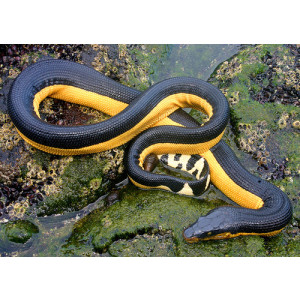Yellow-lipped Sea Krait Did you see this animal?
Scientific Name : Laticauda colubrina
Family : Elapidae
Order : Squamata
Class : Reptilia
Phylum : Chordata
Habitat : Marine
Description : Ventral part of Yellow-lipped Sea Krait is large covering one-third to more than half the width of the body.Nostrils laterally placed where nasals are separated by internasals.Upper lip is yellow.Female larger than male. It is possible that certain types of eels, which serve as a main source of nourishment for yellow-lipped sea kraits, have developed a coevolved tolerance to the venom produced by these sea snakes. Yellow-lipped sea kraits are semiaquatic sea snakes, with juveniles staying in water and adults spending half their time on land and half in the ocean. Adult males are more active on land during mating and hunt in shallower water, while adult females are less active on land during mating and hunt in deeper water. Their body adaptations help them swim, but impede their terrestrial movement, with their crawling speed on land being only slightly more than a fifth of their swimming speed. They exhibit philopatry and return to their specific home islands for digestion, shedding skin, and reproduction. Additionally, yellow-lipped sea kraits have been found with heavy tick infections near the tip of Borneo. Yellow-lipped sea kraits may hunt alone or in large groups with other species such as giant trevally and goatfish. They flush out prey from crevices and holes, while their partners feed on fleeing prey. These snakes can fool predators by making their tail appear like their head. They mainly feed on eels and small fish, with females hunting in deeper water for larger eels and males hunting in shallower water for smaller ones. Adult males often hunt for multiple items, while females hunt for only one prey item per foraging bout. After hunting, they return to land to digest their prey.
Distribution in Bangladesh
References:
description written by: Hajbun Tasnim Preety,Department of Zoology,University of Dhaka ; information source:www.reptile-database.reptarium.cz; photo credit:Nigel Marsh(www.inaturalist.org/people/Nigel Marsh), photo copyright: iNaturalist. more information please contact with us.
description written by: Hajbun Tasnim Preety,Department of Zoology,University of Dhaka ; information source:www.reptile-database.reptarium.cz; photo credit:Nigel Marsh(www.inaturalist.org/people/Nigel Marsh), photo copyright: iNaturalist. more information please contact with us.






































